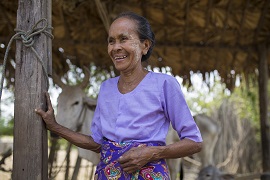FAO assists flood-affected communities prior to the coming rainy season

- Daw Thi received farming tools, seeds and fertiliser from FAO prior to the next rainy season. Credit: FAO/Hkun Lat
After the floods swept through his village in July 2015, Than Win (43) and his two older sons could not find work for nearly three months. As casual agricultural workers, their daily income of 6500K (roughly US$5) was literally buried under the mud.
“I had to sell some of my things in order to buy food for the family, including some special possessions of jewellery that I had bought from savings. We also borrowed money from neighbours,” said Than Win.
The village of Kyun Gyi in the Sagaing region of Myanmar largely consists of small hold farmers, furniture makers and casual agricultural workers like Than Win. All were significantly impacted by the floods associated with Cyclone Komen last year.
“All our furniture making machinery was too heavy to move when the floods came, so it was damaged in the floods with so much water and mud. We had to pay to buy parts and have them repaired before we could start to work again,” said furniture maker Myo Myint (30).
Daw Thi (67) has three acres of land on which she grows groundnut and beans. Her sons help her to farm the land and also get casual work on other farms.
“During the floods, my land was flooded and covered in mud. The land near the river was completely damaged and unusable, cracked from the dried mud. Before I had more land, but now I can only farm three acres,” she said.
All three will receive two piglets each from FAO as part of a CERF-funded project aimed at rebuilding livelihoods for flood-affected communities through supporting or diversifying income generation opportunities.
FAO, together with implementing partner Solidarités International, is assisting 88 households of Kyun Gyi through the provision of livestock and agricultural inputs in advance of the next rainy season. Landless families will receive either two piglets or ten chickens each, including vaccines and feed for two months. Farming families will receive agricultural and home gardening kits, including fertilizer, farming tools and vegetable seeds.
This assistance is part of a larger project – funded by the Central Emergency Response Fund (CERF) administered by UN OCHA - which will assist more than 50 000 flood-affected individuals in four townships of Sagaing region.
Than Win hopes to be able to sell the pigs when they are one year old.
“The FAO pigs will be a good investment as I will be able to breed them and make some extra money which will help me to make more furniture to sell. Sometimes I could get three, sometimes 2.5 lakhs per pig (up to US$250). With FAO’s support of more pigs this can help my family with our livelihoods,” he said.
FAO has called for a total of USD 12.1 million to provide assistance to 332 750 conflict- and flood-affected people under the 2016 Humanitarian Response Plan for Myanmar. With 2016 funding to date, around 62,000 people will be assisted by FAO. Under funding received in 2015, an additional 93 000 flood-affected people are being assisted. A further USD 7.6 million is urgently required to reach the total target population for 2016.
